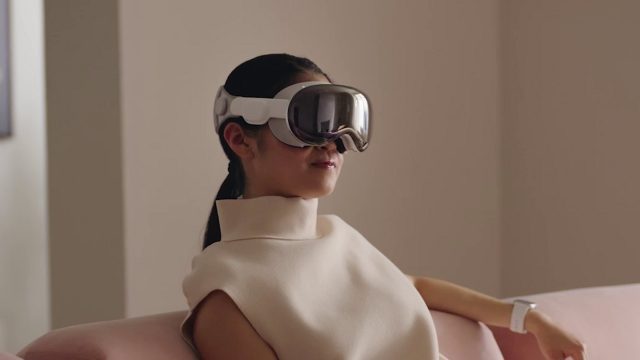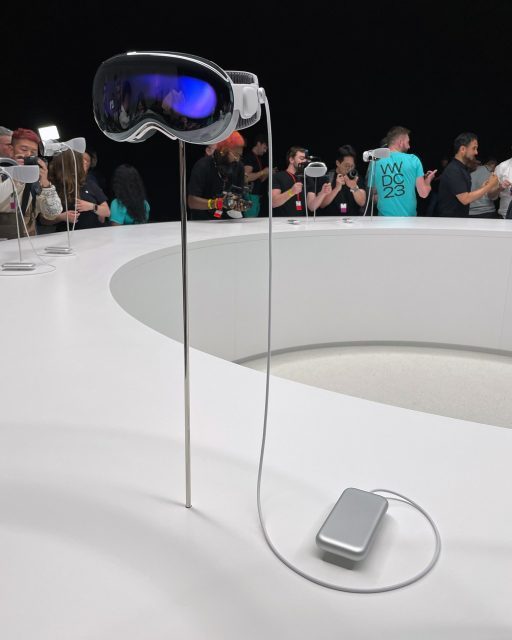Immersion Isn’t Off the Table
While AVP clearly isn’t being positioned as a gaming machine, Apple did show that it’s interested in fully-immersive content, even if it doesn’t expect that to be the most common usage right out of the gate.
In addition to allowing you to swivel the ‘digital crown’ dial on top of the headset to fade into a fully immersive environment as your background, the company also showed an impressive demo where the wall in front of me opened up to reveal a prehistoric environment where a large dinosaur came up to the opening and stuck its head into the room.
The dino, which was rendered in real-time with impressive detail, dynamically reached its head toward me to sniff and snort while investigating me up close. If I moved, it moved to follow me. Just before it looked like it was going to step all the way into the room, it turned around and sauntered off.
For people who have never seen VR before, this will probably be a mind-blowing encounter. As someone who has been immersed in the tech for the last decade, the demo wasn’t anything I hadn’t seen before, but as with the rest of what I saw, the execution was spot-on and the effect was very convincing. Thanks to a great display, convincing passthrough, seamless tracking, and sharp 3D rendering, this was one of those moments where I was more focused on the feeling of Presence—the feeling that this thing was really there in front of me—than the underlying tech at work.
Content Consumption
While Apple has steered away from particularly interactive immersive experiences thus far, the company still wants to entertain. To that end they showed a demo reel of Apple Immersive Videos, a collection of 8K 180-degree 3D live-action videos.
This was a quick-cut reel of a bunch of scenes: a bear in the wild, children playing soccer, a basketball game, an exotic city, a daredevil on a tightrope between two mountains. It was a great showcase of the power of immersive video. Again, I’ve seen this sort of stuff plenty of times over the years, but between the quality of the capture and the fact that this content library is going to be built into Apple TV, there’s a real possibility that this kind of content actually gets viewed, shared, with ease. Unlike most other approaches we’ve seen to date which have relied on third-party apps or poorly constructed content libraries that nobody knows how to find.
If I found an awesome immersive video on AVP and wanted to send it to a friend, I could just click ‘share’ and send them a link via iMessage right from within the headset. Or maybe I’ll just be able to invite them to simply watch it with me. That’s the difference between what Apple is building with AVP and what’s come before. It’s supporting known paradigms with the goal of making obvious things (ie: watch an immersive video with your friend) not just possible, but easy.
The Buts
But… there’s a few buts.
For one, I was hoping Apple would move the needle more on headset ergonomics. AVP isn’t uncomfortable compared to contemporary MR headsets, but it’s still in the same ballpark. I found the headset fairly front-heavy, even with an optional top strap. I’m glad they have the top strap though, because AVP (like most headsets) definitely benefits from it. However, the choice to have the strap go from ear-to-ear (rather than forehead to back-of-head) seems like a mistake because it doesn’t let you lift the headset’s front-heavy weight up quite as well.

It’s difficult to judge headset ergonomics without real long-term usage, but my gut was that Quest Pro is more comfortable thanks to its more balanced design and rigid headstrap.
Luckily AVP’s headstrap is designed with a simple release mechanism that should make third-party headstraps plentiful. And I wouldn’t be surprised if the kind of headstrap people gravitate toward the most includes a top strap that goes from forehead to back-of-head, as well as a mount on the back of the head for the battery (to better balance the weight).

And let’s just get this out there: it’s a big bummer that AVP lacks dedicated motion controllers—even as an optional add-on. The most popular VR games all require VR controllers (and will be painful, if impossible to port for hand-tracking alone). The hardware overall is generally pretty awesome and you can be sure I’d love to play my favorite VR games with it. Sadly that’s not possible and it looks like it won’t be any time soon.
The Price is Insane. Period.
$3,500 is insane for 99% of people, and Apple knows it.
The Pro in Apple Vision Pro indicates as much… this device is for ultra Apple enthusiasts, exceptionally wealthy people who want the latest and coolest tech money can buy, and developers who think they might be able to build a business from the headset and its eventual progeny.
With this first-gen headset, Apple has planted a flag in the ground with Vision Pro, saying, ‘we want the MR experience to be at least this good, regardless of what it costs’. From here the goal is clear: make it smaller, better, and cheaper. And if they keep doing that, future iterations of AVP will become increasingly valuable and increasingly accessible to more and more people. If this is the bar they’re setting for themselves (and by extension, the rest of the XR industry), then the future is looking very bright… even if it’s not quite here yet.






